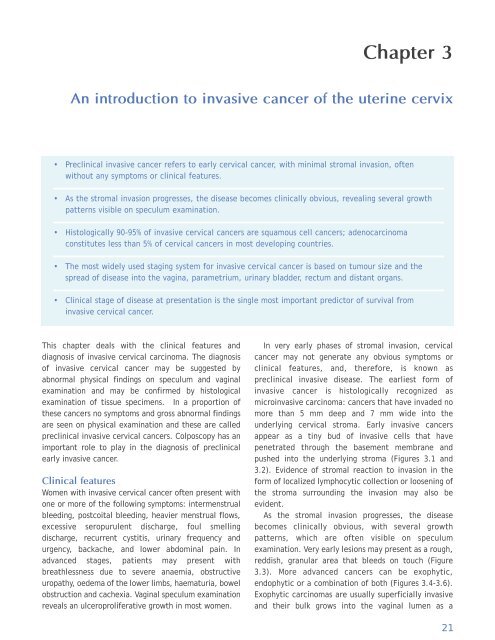Colposcopy and Treatment of Cervical Intraepithelial Neoplasia - RHO
Colposcopy and Treatment of Cervical Intraepithelial Neoplasia - RHO
Colposcopy and Treatment of Cervical Intraepithelial Neoplasia - RHO
You also want an ePaper? Increase the reach of your titles
YUMPU automatically turns print PDFs into web optimized ePapers that Google loves.
Chapter 3<br />
An introduction to invasive cancer <strong>of</strong> the uterine cervix<br />
• Preclinical invasive cancer refers to early cervical cancer, with minimal stromal invasion, <strong>of</strong>ten<br />
without any symptoms or clinical features.<br />
• As the stromal invasion progresses, the disease becomes clinically obvious, revealing several growth<br />
patterns visible on speculum examination.<br />
• Histologically 90-95% <strong>of</strong> invasive cervical cancers are squamous cell cancers; adenocarcinoma<br />
constitutes less than 5% <strong>of</strong> cervical cancers in most developing countries.<br />
• The most widely used staging system for invasive cervical cancer is based on tumour size <strong>and</strong> the<br />
spread <strong>of</strong> disease into the vagina, parametrium, urinary bladder, rectum <strong>and</strong> distant organs.<br />
• Clinical stage <strong>of</strong> disease at presentation is the single most important predictor <strong>of</strong> survival from<br />
invasive cervical cancer.<br />
This chapter deals with the clinical features <strong>and</strong><br />
diagnosis <strong>of</strong> invasive cervical carcinoma. The diagnosis<br />
<strong>of</strong> invasive cervical cancer may be suggested by<br />
abnormal physical findings on speculum <strong>and</strong> vaginal<br />
examination <strong>and</strong> may be confirmed by histological<br />
examination <strong>of</strong> tissue specimens. In a proportion <strong>of</strong><br />
these cancers no symptoms <strong>and</strong> gross abnormal findings<br />
are seen on physical examination <strong>and</strong> these are called<br />
preclinical invasive cervical cancers. <strong>Colposcopy</strong> has an<br />
important role to play in the diagnosis <strong>of</strong> preclinical<br />
early invasive cancer.<br />
Clinical features<br />
Women with invasive cervical cancer <strong>of</strong>ten present with<br />
one or more <strong>of</strong> the following symptoms: intermenstrual<br />
bleeding, postcoital bleeding, heavier menstrual flows,<br />
excessive seropurulent discharge, foul smelling<br />
discharge, recurrent cystitis, urinary frequency <strong>and</strong><br />
urgency, backache, <strong>and</strong> lower abdominal pain. In<br />
advanced stages, patients may present with<br />
breathlessness due to severe anaemia, obstructive<br />
uropathy, oedema <strong>of</strong> the lower limbs, haematuria, bowel<br />
obstruction <strong>and</strong> cachexia. Vaginal speculum examination<br />
reveals an ulceroproliferative growth in most women.<br />
In very early phases <strong>of</strong> stromal invasion, cervical<br />
cancer may not generate any obvious symptoms or<br />
clinical features, <strong>and</strong>, therefore, is known as<br />
preclinical invasive disease. The earliest form <strong>of</strong><br />
invasive cancer is histologically recognized as<br />
microinvasive carcinoma: cancers that have invaded no<br />
more than 5 mm deep <strong>and</strong> 7 mm wide into the<br />
underlying cervical stroma. Early invasive cancers<br />
appear as a tiny bud <strong>of</strong> invasive cells that have<br />
penetrated through the basement membrane <strong>and</strong><br />
pushed into the underlying stroma (Figures 3.1 <strong>and</strong><br />
3.2). Evidence <strong>of</strong> stromal reaction to invasion in the<br />
form <strong>of</strong> localized lymphocytic collection or loosening <strong>of</strong><br />
the stroma surrounding the invasion may also be<br />
evident.<br />
As the stromal invasion progresses, the disease<br />
becomes clinically obvious, with several growth<br />
patterns, which are <strong>of</strong>ten visible on speculum<br />
examination. Very early lesions may present as a rough,<br />
reddish, granular area that bleeds on touch (Figure<br />
3.3). More advanced cancers can be exophytic,<br />
endophytic or a combination <strong>of</strong> both (Figures 3.4-3.6).<br />
Exophytic carcinomas are usually superficially invasive<br />
<strong>and</strong> their bulk grows into the vaginal lumen as a<br />
21
















